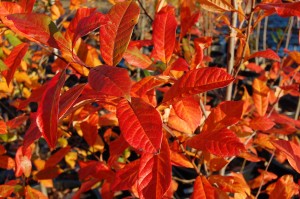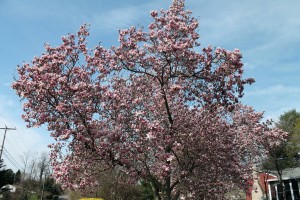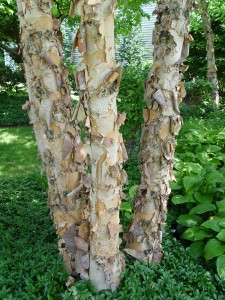Top 10 Shade Trees
July 7th, 2015
Here’s the last installment of my three-part mini-series on favorite plants… this one on 10 shade trees worth giving a look.
Make sure you have the space because all of these grow 30 feet tall and up. If you’re gardening in a smaller space, you might want to check out my earlier post on Top 10 Small Trees.
Most of the following are grown for their shade, structure and fall-foliage interest, although a few also offer some blooming interest.
For more of my favorite (and not-so-favorite) plants, check out my George’s Favorite Stuff page.
1.) Black gum ‘Wildfire’ (Nyssa sylvatica). Also known as “tupelo” and “sour gum,” this is a native Pennsylvania shade tree that I think rivals maples for fall foliage.
‘Wildfire’ is a particularly nice variety of black gum because its new leaves come out reddish-purple in addition to its spectacularly brilliant scarlet fall foliage.
It’s a slow to moderate grower, going to 40-50 feet tall and 25-30 feet wide in 25 years.
Although the flowers aren’t noticeable, bees find them and like them. ‘Wildfire’ is a seedless selection, so it doesn’t get the small, bird-attracting fall fruits that the straight species does. Gardeners who don’t like “messy” will like this trait; wildlife fans won’t, so go with the straight species if you’re in that camp.
Black gum tolerates and even prefers damp soil, and it also needs at least mildly acid soil. Other than that, this is an easy-to-grow, long-lived shade specimen.
2.) Katsura (Cercidiphyllum japonicum). Few people know this species, which I think is one of the most elegant shade trees with its broad upright canopy, strong limbs and colorful leaves.
Katsura is a moderate grower, reaching 50-60 feet tall and 25-30 feet across in about 25 years.
The leaves are heart-shaped – similar to redbud – and emerge reddish before settling into a bluish-green shade for summer. Fall foliage is a bright, clear gold… very nice.
A bonus of the fall foliage is that if you crush the leaves, they smell like burnt sugar.
Keep young katsuras well watered for the first several years because the species’ only soft spot is that it’s not very drought-tolerant. Leaves will scorch around the edges as an early sign of lack of soil moisture. Otherwise, it hardly ever runs into bug or disease issues.
3.) Red maple (Acer rubrum). For my money, this species runs neck and neck with black gum as Pennsylvania’s best native shade tree.
Red maple is a fast-grower and is a good choice for occasionally wet sites since its roots can tolerate poor drainage and wet soil better than most species.
The leaves have three main lobes and emerge reddish. But the real show is fall when the leaves of the best varieties turn brilliant red. Three of the best for fall color are Redpointe, Red Sunset and October Glory.
Figure on a size of 50-60 feet tall and 30-35 feet wide in 25 years. Avoid salty sites.
4.) Freeman maple Autumn Blaze (Acer x freemanii ‘Jeffersred’). This is one of the toughest shade trees you’ll find because it’s a hybrid that combines the showiness of red maple with the durability of silver maple.
Autumn Blaze is very tolerant of heat, wind, and wet soil, and it’s adaptable to most soils (except salty) as well as urban air pollution. It’s also strong-limbed. Basically, it tolerates most anything you can throw at it without producing potentially invasive seeds.
It’s a fast grower to 50-60 feet tall and 30-40 feet wide in 25 years.
5.) White oak (Quercus alba). You won’t find any bigger, stronger, or more majestic American hardwood than this Pennsylvania-native oak.
The white oak gets its name from its flaky, light gray bark (almost white). The leaves are sharply lobed and go from glossy green to russet-red in fall.
White oak also is a heavy acorn producer, which makes it one of the best choices if you’re trying to be kind to native mammals (but not such a good choice if you’re looking for a tree for next to the patio).
White oak’s growth rate is slow to moderate, but it can eventually work its way up to 80 feet tall and wide – or more.
6.) Purple beech ‘Riversii’ (Fagus sylvatica). I like most beeches in general for their imposing stature and smooth, gray, elephant-leg-like trunks, but this particular one adds the feature of glossy burgundy/foliage leaves.
‘Riversii’ is the most common purple-leaf beech you’re likely to run across, other than a couple of weeping purple-leaf varieties that are nice but more specimens than shade trees.
‘Riversii’ is fairly slow-growing but gradually works its way up to about 50 feet tall and 40 feet in 25 years.
The leaf color morphs from dark to a more coppery shade in fall. Avoid wet soil, be patient, and you (and your ancestors) will enjoy an eye-grabbing big tree for decades.
7.) Saucer magnolia (Magnolia x soulangeana). Few trees are showier in bloom than this winter-hardy magnolia that’s covered with large pinkish-white flowers in mid-spring.
Saucer magnolia grows at a moderate rate but comes out on the short end of shade-tree status – about 30 feet tall and wide after 25 years.
It’s not as showy in fall as the maples and gums, but you’ll get a decent performance of yellow before the leaves drop for winter.
Avoid wet spots or areas that get blasted by cold wind since the flower buds occasionally are killed by late frost.
8.) River birch (Betula nigra). This Pennsylvania native best known for its peeling cinnamon-colored bark is a more durable choice than the bug- and disease-prone white birch.
Don’t under-estimate how big this species can get, as many people do who plant one 4 feet off a house corner. River birch grows fairly fast to 40 or more feet tall with a spread of 25 to 30 feet.
This species prefers damp, acidy soil, so you’ll do it a favor by occasionally deep-watering in hot, dry weather.
River birch is useful to native birds and butterflies, but it can be “messy” with dropping racemes, petals and leaves if you’re looking for something near a patio. Fall foliage is a nice shade of rich gold.
Dura Heat is a good variety for its improved heat tolerance, and the 15-foot Fox Valley (‘Little King’) is a good choice if you don’t have the space for a full-sized birch.
9.) Ginkgo (Ginkgo biloba). This is one of the most recognized trees because of its distinctive fan-shaped leaves that just about every elementary-school kid collects for their leaf project. (I hope kids still do leaf projects.)
Ginkgo also has the benefit of being extremely durable. It’ll do heat, drought, pollution, wind, rogue winters and just about anything else, which explains why it’s often chosen as a street tree in cities and has survived since dinosaur times.
Ginkgos grow fairly fast to about 50 feet tall and 30 feet wide. ‘Princeton Sentry’ and Golden Colonnade are narrower varieties that grow about 20 feet wide if you’re more interested in staying within a boundary than maximizing shade.
Fall foliage is bright gold, and the variety ‘Autumn Gold’ is the best I’ve ever seen for fall color.
10.) Littleleaf linden (Tilia cordata). The littleleaf linden is another good shade tree that gets widespread use in cities because it’s so durable and pollution-tolerant. It’s definitely a survivor.
It’s also a decent tree for pollinators, although not quite as good as the native American linden (Tilia americana). Bees like the dangling and somewhat fragrant yellow flower chains in early summer.
The leaves are heart-shaped and have a bluish tint to them in summer before turning yellow in fall.
Littleleaf linden grows at a moderate rate and can end up 60 to 70 feet tall and 30 to 40 feet wide in 25 years.












